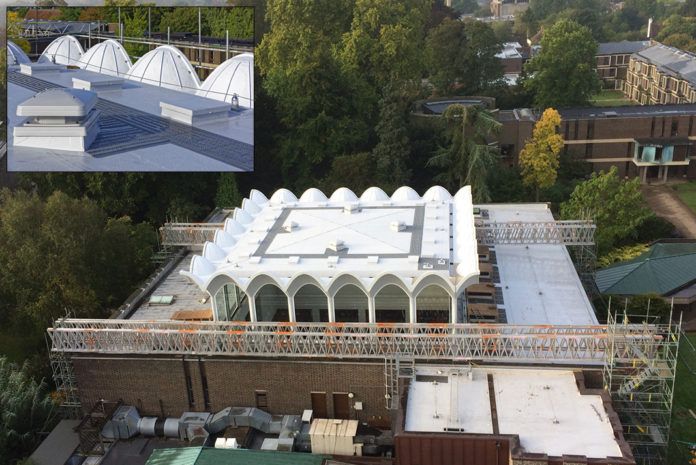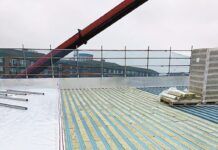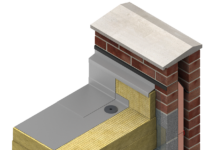
Single ply roofing manufacturer Sika Sarnafil, architects Cullinan Studio and Roofing Contractors Cambridge (RCC) are celebrating following a win at the first-ever AJ Specification Awards.
The roof refurbishment of the Central Building at Cambridge University’s Fitzwilliam College – one of the first major projects to use a new approach to Sika Sarnafil’s products – came out on top in the Roofing and Drainage category.
Announced at a ceremony held at The Principal Hotel in Manchester on Friday, February 15, prizes were taken home across a total of 12 categories for projects demonstrating outstanding working relationships between architects, manufacturers and suppliers.
In what was a skilful collaboration between Sarnafil, Cullinan and RCC, the judges agreed there was something special about the way this brutalist building had been ‘beautifully protected’.
Comprising protruding ‘scalloped’ detailing, a waterproofing solution was created to refurbish the complex roof, all without visually altering the original 1960s Denys Lasdun design.
Sika Sarnafil’s single ply membrane and Sikalastic 621 – a liquid-applied product typically used for areas with complex detailing – were used across large areas. This pairing of systems was further enhanced by Sika Refurbishment’s SikaFloor 420.
Sika Limited’s concrete products were also specified for the build by concrete repair contractors Gunite Eastern. Sika’s innovative concrete repair system included a steel corrosion inhibitor. Sika FerroGard-903+, which penetrates the concrete and forms a protective monomolecular layer on the surface of the reinforcing steel, was used alongside Sika MonoTop repair mortars. The concrete was finished with Sikagard-550W, a high-performance anti-carbonation coating, with crack-bridging capabilities, that protects the concrete, while meeting the aesthetic requirements of the structure.
Sika has a wide range of products available for most applications within the construction industry, which can range from waterproofing, flooring, concrete, sealing and bonding, façade, roofing and refurbishment applications, as well as teams of specialists available to advise on specific projects. Using a combination of systems, while working internally within the company, Sika was able to advise on the most suitable materials for different aspects of the project and ultimately provided a complete building envelope solution, with the client benefitting from having only one supplier to deal with.
Neil Smith, technical advisor at Sika Sarnafil, said: “We’re exceptionally proud that the teams across Cullianan Studio, RCC and Sika Sarnafil have been commended by the AJ Specification Awards. The winning project posed a huge design challenge, which was met with a unique approach and use of materials. Completed early and on budget, while the college remained operational throughout, the success of this project is testament to the close working relationships we foster with our highly skilled architects, contractors and clients, while also providing the best quality products.”
Dave Stewart at RCC said he was thrilled to see a project his team had worked on recognised in such prestigious awards: “The central Building Lantern roof was very unusual, presenting numerous detailing challenges that we welcomed. We worked closely with Sika Sarnafil and carried out multiple site tests to ensure the junction between the Sikalastic 621 and single ply membrane was formed using the most effective methods. The use of Sarnametal created a strong bond between the two products, enabling them to be successfully sealed together. This was a challenging and enjoyable project that demonstrates how well these products can work together for roofs with incredibly complex detailing.”
Alex Abbey from Cullinan Studio added: ”We are thrilled that, together as a team, we have won this award. This iconic, brutalist gem of a building is now renewed and preserved for many years to come due to an innovative shell, fascia and roof waterproofing solution, achieved through collaboration. The pioneering approach developed on this project can now be applied to protect other buildings, opening up new possibilities for roof design in the future.”



